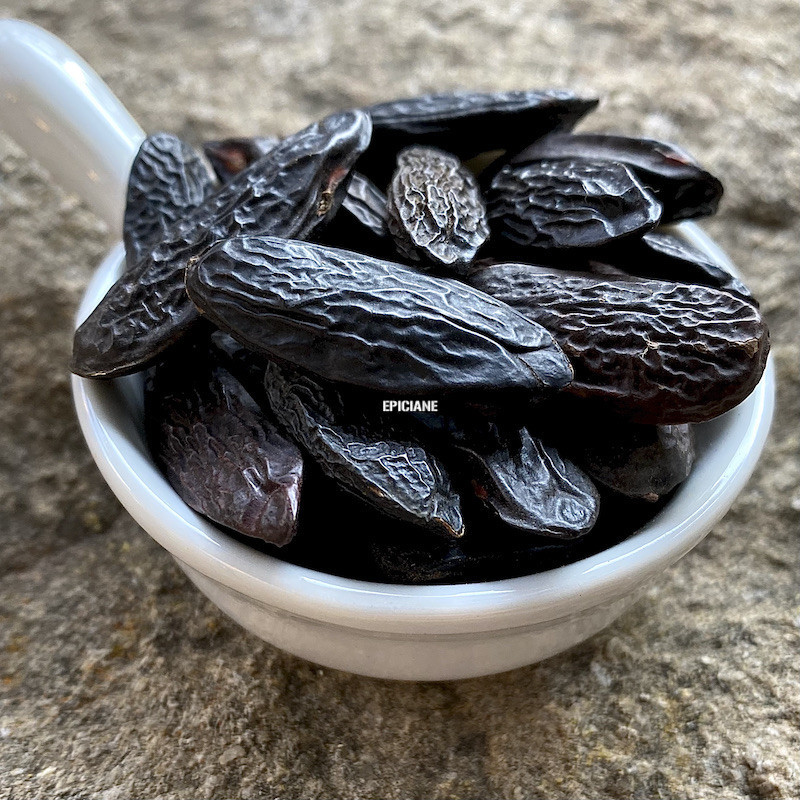
Reference: 3N7137901



The aroma of this large black seed is powerful and truly unforgettable, blending notes of vanilla and spice!
Grated or infused, it’s delightful for flavoring chocolate and custards, as well as enhancing scallops and even certain meats.
 Delivery
Delivery
Mondial Relay
 Returns
Returns
See conditions
 Payments
Payments
100% secure
Livré en sachet refermable
Plante cultivée ou sauvage selon arrivages - Récolte manuelle -Séchage à l'air libre - Sans OGM ni ionisation ni nanomatériaux
Uses in Cooking and Beyond:
The exceptional aroma of Tonka beans is worth savoring all on its own! Its warm, potent fragrance, reminiscent of almond and vanilla, is truly unique. Many perfumers recognize its allure, and it’s used in numerous fragrance compositions.
In the kitchen, Tonka beans are almost always grated (using a grater or even a peeler), primarily in sweet dishes, where it often accompanies vanilla—or even replaces it! It has become a classic pairing with chocolate, and is delightful in custards, fruit-based desserts, ice cream, pastries, and even madeleines. It's also delicious when grated into coffee or tea, and you can find it in our punch spice blend.
While Tonka is amazing in sweet dishes, it’s equally extraordinary in some savory dishes. It pairs beautifully with scallops, veal, a cream sauce over fresh pasta, or even in an omelet, lending it an almost mushroom-like flavor.
As with any spice, it’s best to add it gradually and taste as you go, as Tonka’s potent aroma can easily overpower a dish.
Like vanilla beans, some batches may have tiny, bright, sugar-like crystals on their surface. This natural crystallization doesn’t affect the quality of the beans and occurs with temperature variations.
Fun Fact: Tonka beans naturally contain coumarin, just as cinnamon does. In the food industry, it’s sometimes used as a vanilla flavor substitute.
Lastly, its scent is so intense that Tonka beans can even be used as potpourri to perfume a room!
Who Am I? Origin: Brazil
Scientific Name: Dipterix odorata
Other Names: Coumarou, coumaron, coumarin
The Tonka bean is the seed of a tropical tree native to South America, known in Brazil as Cumaru. This tree, reaching up to 30 meters in height, is also valued for its durable wood, used in boat construction. The fruit, which resembles a mango, ripens and falls to the ground from July to October. After collection, the fruit is dried, the seeds are extracted, then soaked in alcohol, and dried again. The resulting black or dark brown, wrinkled beans are around 3–4 cm long.
Tonka’s almond, powdery, vanilla-like, and exotic notes are sought after in fragrances, especially in fougère or oriental accords. Perfumers like Guerlain have used it since the 19th century in "Jicky," and more recently in "L’Heure bleue" and "Tonka impériale." Other major brands, like Lalique, Réminiscence, Chanel, and Yves Saint Laurent, have also embraced it.
Historical Tidbit: Once, Tonka beans were added to tobacco for their distinctive vanilla scent and taste. While the West only recently discovered it, Amazonian Indigenous people have long regarded it as a good luck charm.
Data sheet
Reference: 3N7137901
Reference: vanillebourbonE
Reference: ecorceorangeamere
Reference: ecorcecitronH
Reference: Ecorceorange
Reference: badianeM
Reference: badianeE
Reference: EPI230204
Reference: gentiane
Reference: 3N7137901
Reference: 26545D
Reference: baieroseE
Reference: 3913
Reference: 10N7738802
Reference: punch
Reference: bergamote
Reference: 6470

The aroma of this large black seed is powerful and truly unforgettable, blending notes of vanilla and spice!
Grated or infused, it’s delightful for flavoring chocolate and custards, as well as enhancing scallops and even certain meats.